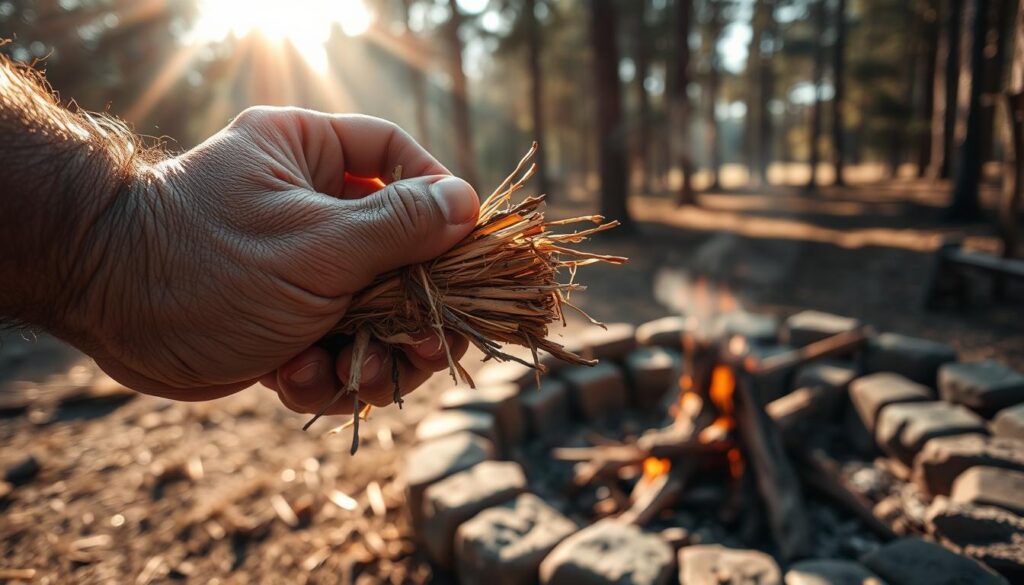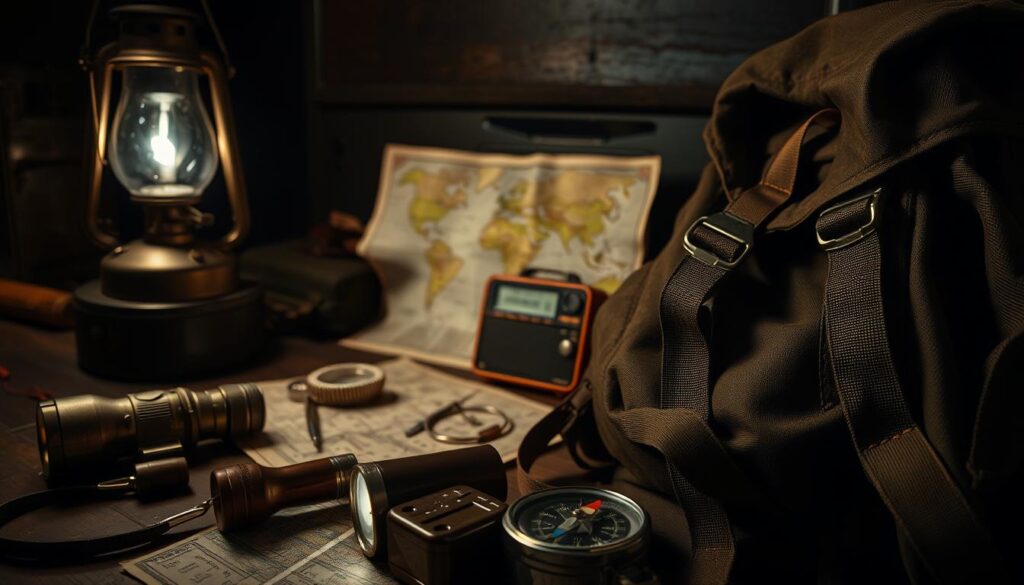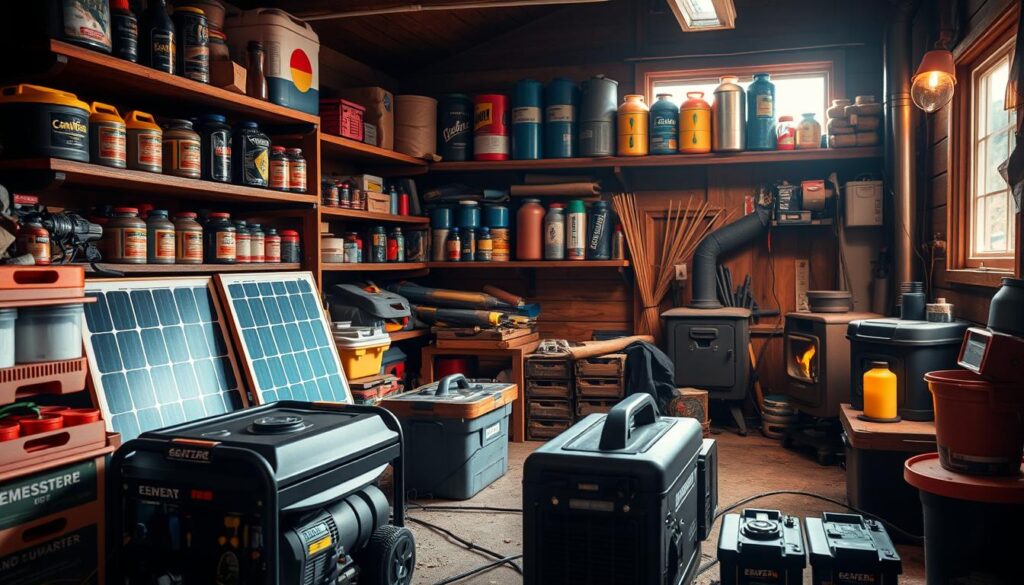Being in the wilderness and needing to start a fire is a survival issue. It’s not just for warmth. It’s also for cooking and signaling for help.
Knowing how to light a fire is key. This guide will teach you how to do it step by step. You’ll learn to start a fire even when it’s hard.
Key Takeaways
- Understand the importance of fire lighting in survival situations.
- Learn the step-by-step process of lighting a fire.
- Discover the right materials to use as kindling and fire starters.
- Master techniques to keep your fire burning steadily.
- Safety precautions to take when handling fire in the wilderness.
Understanding Fire Lighting Basics
Before you try to light a fire, it’s important to know the basics. Fire lighting isn’t just about starting a flame. It’s about understanding the key principles behind it.
The fire triangle is key to knowing how fires start and stay lit. It shows the three main things needed for a fire: fuel, heat, and oxygen. Knowing this helps you safely start and keep a fire going.
The Importance of Fire Safety
Fire safety is very important when lighting a fire. Making sure your fire is controlled and safe is key to avoid accidents. Here are some fire safety tips:
- Always choose a safe location for your fire, away from flammable materials and overhanging branches.
- Keep a bucket of water or a fire extinguisher nearby.
- Monitor the wind direction to avoid sparks igniting nearby objects.
- Never leave a fire unattended.
By following these tips, you can greatly reduce the risk of accidents. This makes your fire lighting experience safe and enjoyable.
Essential Fire Lighting Terminology
Knowing the terms of fire lighting can help you build and keep a fire. Key terms include:
- Combustion: The process of burning, which involves a chemical reaction between a fuel source and oxygen, releasing heat and light.
- Fuel: The material that is burned to produce a fire, such as wood, charcoal, or other combustible materials.
- Kindling: Small, easily ignitable twigs and sticks used to start a fire.
- Tinder: Highly flammable material, such as dry leaves or grass, used to catch sparks and start a fire.
Knowing these terms helps you understand fire lighting better. It also improves your skills.
Preparing for Fire Lighting
To light a fire, you need to prepare well. Choose the right spot and gather the right materials. This makes sure your fire lighting is safe and fun.
Choosing the Right Location
Finding the perfect spot for your fire is key. Look for a fire pit or a clear area away from things that can catch fire. Make sure it’s level and not windy. Always check for any local fire rules before you start.
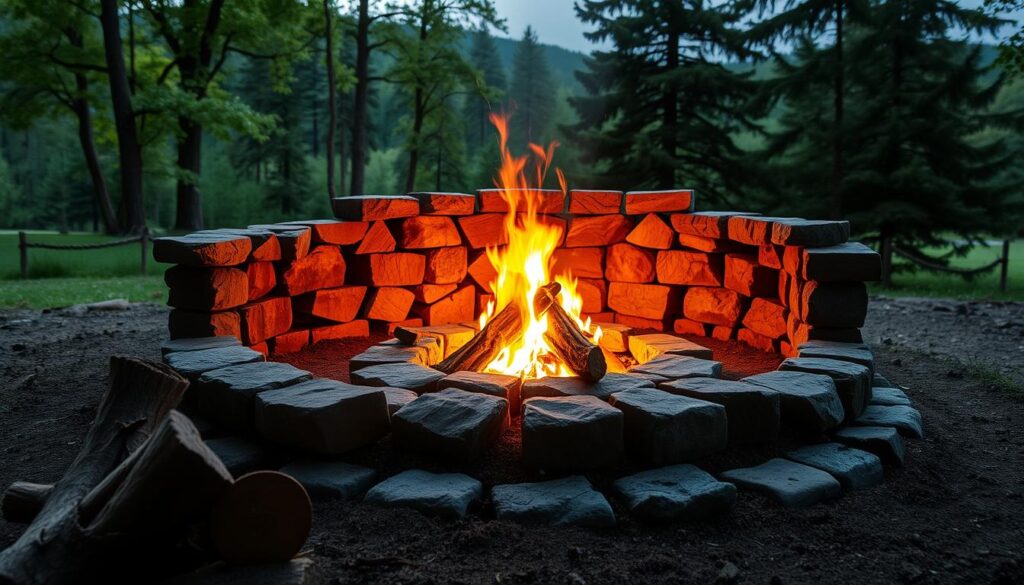
Gathering Necessary Materials
You’ll need tinder, kindling, and fuel. Tinder is dry, fluffy stuff that lights easily, like dry leaves or grass. Kindling are small sticks, and fuel are bigger logs or firewood. For more tips on survival lighting, check out mastering survival lighting.
- Tinder: Dry leaves, grass, or small dry twigs
- Kindling: Small sticks, thin branches
- Fuel: Larger logs, firewood
Types of Fuels and Their Uses
Knowing about different fuels is important for your fire. Dry firewood is great for a fire that lasts a long time. Softer woods like pine are good for starting fires. The fuel you pick changes how long your fire burns and how hot it gets.
| Fuel Type | Use | Characteristics |
|---|---|---|
| Dry Firewood | Main fuel for long-lasting fires | High heat output, long burn time |
| Pine or Softwood | Kindling, starting fires | Easier to ignite, shorter burn time |
Building Your Fire Structure
The way you build your fire is key to its efficiency and safety. A well-made fire burns better and is safer. It also lowers the chance of accidents.
There are many ways to build a fire structure, each with its own benefits. Knowing these methods helps you pick the best one for your needs and setting.
Teepee Method
The teepee method uses tinder in a teepee shape. It leaves space in the middle for air to help start the fire. This method is great for quick starts because it lets air flow well.
To build a teepee structure:
- Put a small amount of tinder in the center of your fire pit.
- Arrange kindling around the tinder in a teepee shape.
- Light the tinder, and once the kindling starts to burn, add more fuel as needed.
Log Cabin Method
The log cabin method builds a fire with logs, making a stable and long-lasting fire. It’s perfect for big fires that need to burn for a long time.
To construct a log cabin fire:
- Start by placing two larger logs parallel to each other on the fire pit.
- Place smaller logs perpendicularly across the base logs.
- Continue adding layers, alternating the direction of the logs.
- Leave space in the center for air to flow and for the initial tinder and kindling.
Lean-To Method
The lean-to method leans kindling against a larger log, creating a sheltered spot for the fire. It’s good for windy conditions because it protects the flame.
| Method | Advantages | Best Use |
|---|---|---|
| Teepee | Easy to start, good airflow | Quick fires, camping |
| Log Cabin | Long-lasting, stable | Extended camping, cooking |
| Lean-To | Wind protection, sheltered flame | Windy conditions, survival |
By learning and using these fire structure methods, you can have a safe and efficient fire. It will meet your needs.
Ignition Techniques
Learning various ignition techniques is key for outdoor fun. Whether camping, hiking, or having a backyard fire, knowing how to start a fire is important.
Using Matches and Lighters
Starting a fire with matches or lighters is easy. But, it’s important to use them safely. Always strike matches away from you and have water or sand ready to put out fires.
Lighters give a steady flame and work well in the wind. Make sure your lighter works before you need it.
Fire Starters: Natural vs. Synthetic
Fire starters are natural or synthetic, each with benefits. Natural fire starters like leaves and twigs are easy to find. But, they don’t work well when it’s wet.
Synthetic fire starters like ferrocerium rods and fire paste are more reliable. They work in wet conditions too.
“The best fire starter is one that you are comfortable using and that suits the conditions you are in.”
Advanced Techniques: Flare and Bow Drill
For a challenge, try the flare or bow drill methods. The flare method makes sparks by rubbing wood or using a magnifying glass.
The bow drill is ancient. It uses a bow to make heat on a fireboard. It takes practice but is rewarding.
In summary, learning different ways to start a fire makes outdoor activities better. From simple tools to the bow drill, having many skills is useful.
Maintaining Your Fire
To keep my fire burning well, I adjust airflow and add fuel correctly. It’s not just about keeping it lit. It’s about doing it safely and efficiently.
Adjusting Airflow for Optimal Burn
Getting the airflow right is key for a good burn. I control the airflow to change the fire’s intensity. Too little oxygen, and it smolders and smokes. Too much, and it burns too fast, wasting fuel.
To adjust airflow, I need to know my fire’s structure. This means changing the log arrangement or using vents. These tweaks help the fire burn its best.
Adding Fuel Without Smothering
When adding fuel, I must avoid smothering the flames. I add fuel slowly and gently, making sure the fire gets enough oxygen. This keeps the flames burning well.
To add fuel without smothering, I place new fuel in a way that doesn’t block the fire. For example, I add bigger logs around the fire. This lets the fire grow without being suffocated.
Fire Safety Precautions
Fire safety is key. Taking the right steps can make a big difference. It’s important to create a safe space for your fire and be ready for emergencies.
Creating a Safe Fire Zone
To make a safe fire area, clear away flammable stuff like dry leaves or twigs. If you can, use a fire pit or ring to keep the fire in. This helps stop the fire from spreading and lowers accident risks.

Handling Emergencies
Having a plan for emergencies is vital. Keep a bucket of water or a fire extinguisher close by. Knowing how to use them is also important.
| Emergency Situation | Action to Take |
|---|---|
| Fire getting out of control | Use water or fire extinguisher to extinguish the fire |
| Fire spreading to surrounding areas | Clear the area of flammable materials and contain the fire |
By following these steps and being ready, you can lower accident risks. This way, you can enjoy the campfire safely.
Extinguishing Your Fire
Putting out your fire safely is key when you’re outdoors. It’s important to make sure your campfire is fully out to avoid forest fires and accidents.
There are different ways to put out a fire, depending on the fire and what you have. Water and smothering are two common methods.
Using Water vs. Other Methods
Water is often used to put out fires, like those from wood. It cools the fuel down until it can’t burn anymore. But, water isn’t good for all fires, like electrical ones or fires with flammable liquids.
Smothering works well when you can’t use water. It stops the fire by taking away the oxygen it needs to keep burning. You can smother a fire with a non-flammable material or a fire extinguisher.
| Method | Suitable For | Not Suitable For |
|---|---|---|
| Water | Wood, paper, cloth | Electrical fires, flammable liquids |
| Smothering | Flammable liquids, electrical fires | Some metal fires |
Ensuring Complete Extinguishment
It’s very important to make sure the fire is fully out. Check the ashes or embers to see if they’re cool. For wood fires, you can wet the ashes, stir them, and then check again.
Steps to Ensure Complete Extinguishment:
- Douse the fire with water.
- Stir the ashes to ensure everything is extinguished.
- Check the temperature of the ashes by feeling them with the back of your hand.
- Repeat the process until you’re certain the fire is out.
By following these steps and choosing the right method, you can make sure your fire is fully out. This keeps everyone safe and prevents fires from starting again.
Enjoying the Fire
Enjoying a fire is more than just watching the flames. It’s about making memories. I’ve learned that the real joy comes from the activities we do around the fire.
Cooking Over Fire: Tips and Recipes
Cooking over a fire is a fun experience. It lets us make simple yet tasty meals. One favorite dish is a campfire skillet meal with sausage, potatoes, and veggies.
To cook well, adjust the heat by changing the airflow. Use a cast-iron skillet for even heat. It’s important to keep things simple and watch the cooking time.
Try grilled fish with herbs, roasted veggies, and campfire skillet desserts like apple crisp. Simple ingredients and careful timing are key. Remember, “The best camping meals are those that are simple, yet satisfying.”
“The campfire is a symbol of gathering, of community, and of sharing stories and meals together.”
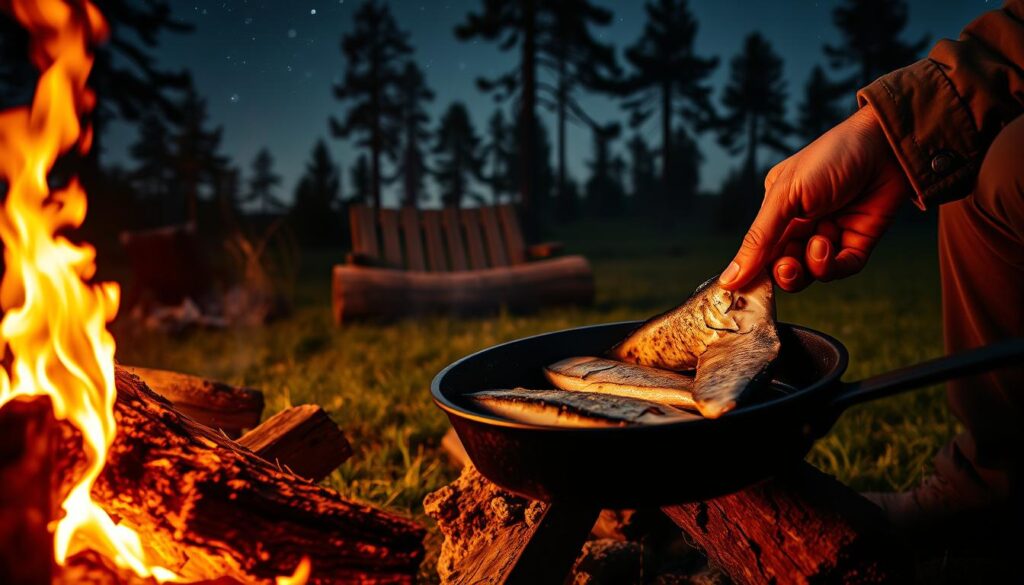
Socializing Around the Fire
Socializing by the fire is special. It’s a chance to bond with loved ones, share stories, and make memories. To make it welcoming, arrange seats in a circle. This encourages everyone to talk and feel close.
For great fire-side chats, be present, share stories, and play games. As Mark Twain said, “The campfire has always been a place of warmth, comfort, and camaraderie.” Embracing these moments strengthens our bonds and creates lasting memories.
- Share stories and experiences
- Engage in campfire games and activities
- Enjoy the company of others in a relaxed setting
Fire Lighting in Different Conditions
Whether you’re camping in the rain or facing gusty winds, knowing how to light a fire is key. Fire lighting is a basic skill that can be tough in bad weather. But with the right methods, you can do it.
Lighting a Fire in Wet Weather
Lighting a fire in wet weather needs careful planning and the right stuff. You must use dry tinder and kindling. This is because wet conditions make it hard for the fire to start and stay lit. For more tips, check out this resource on starting fires in tough weather.
To begin, collect your materials and keep them dry. Use a waterproof match case or keep matches and lighters dry. Look for dry spots under trees or rocks for dry tinder.
Essential Materials for Wet Weather:
- Dry tinder (e.g., dry leaves, grass, or small twigs)
- Kindling (e.g., small sticks)
- Waterproof matches or lighters
- Fire starter (e.g., ferrocerium rod)
Building Fires in High Winds
Building a fire in high winds needs special strategies. Wind can put out a fire or make it hard to start. To fight this, make a windbreak or build a fire pit to protect your fire.
A windbreak can be as simple as a rock wall or a snowbank. You can also use a portable windscreen or make one with your gear. Building a fire pit with rocks or digging a pit can also shield the fire from wind.
| Wind Speed | Fire Lighting Challenges | Solutions |
|---|---|---|
| Low | Easy to light, but may not sustain well | Use a fire pit or windscreen |
| Moderate | Difficult to sustain, may require more tinder | Increase tinder and kindling, use a windbreak |
| High | Very challenging to light and sustain | Use a robust windbreak, build a fire pit, and have a reliable fire starter |
“The ability to start a fire under any condition is a vital survival skill. It provides warmth, light, and a means to cook food, making it a cornerstone of outdoor adventure.”
Eco-Friendly Fire Lighting
Using eco-friendly methods for lighting fires is key to reducing our impact on the environment. As outdoor lovers, we need to think about how our actions affect nature.
Lighting fires can be fun and good for the planet. By picking the right materials and methods, we can lessen our harm to the environment.
Choosing Sustainable Fuels
Choosing sustainable fuels is a big part of eco-friendly fire lighting. Using firewood from local sources cuts down on emissions and helps the local economy.
It’s also important to pick firewood that’s harvested and dried right. This makes the fire burn better, cuts down on smoke, and pollution.
Minimizing Smoke and Pollution
Reducing smoke and pollution is another big deal in eco-friendly fire lighting. Dry firewood is essential because it burns cleaner and makes less smoke.
Keeping the fire well-maintained is also key. This means adjusting airflow and adding fuel carefully to keep the fire burning well.
- Use dry, seasoned firewood to reduce smoke.
- Maintain proper airflow for a clean burn.
- Add fuel gradually to avoid smothering the fire.
Final Thoughts on Fire Lighting
As we wrap up our guide on how to light a fire, thinking about our experiences is key. Sharing these stories helps us find better ways to start and keep a fire going. This way, we can all learn from each other.
Reflecting on My Fire Lighting Experiences
Looking back, it’s important to understand the details of starting a fire. Whether you’re new to it or have done it before, learning from both successes and failures is vital. This helps us get better at starting fires, no matter where we are.
Encouraging Safe Practices for All
It’s critical to teach everyone how to light fires safely. This keeps accidents from happening and makes sure everyone has a good time. By focusing on safety and being careful with fire, we can all enjoy fire lighting without worry.
FAQ
What are the three essential elements for a fire to exist?
For a fire to start, you need fuel, heat, and oxygen. This is shown by the fire triangle.
What are the different types of fuels used for fire lighting?
There are three main types of fuel for starting a fire. Tinder is the smallest, kindling is a bit bigger, and fuel is the largest. Each has a specific role in starting a fire.
What are some common methods for igniting a fire?
Many people use matches or lighters to start a fire. You can also use natural or synthetic fire starters. Advanced methods like the flare and bow drill are also options.
How do I maintain a fire for optimal burn?
To keep a fire burning well, adjust the airflow. Add fuel carefully to avoid putting out the flames. This ensures the fire burns steadily and safely.
What are some fire safety precautions I should take?
To stay safe, clear the area of anything that can catch fire. Build a fire pit to contain the fire. Also, have a plan ready for when you need to put out the fire.
How do I extinguish a fire safely?
Water is often used to put out fires. But, smothering can also work. Make sure the fire is completely out to avoid it starting again.
Can I light a fire in wet weather or high winds?
Yes, you can light a fire in wet weather if you use dry tinder and kindling. In high winds, build a fire pit and use windbreaks to keep the fire safe.
How can I minimize the environmental impact of fire lighting?
Use sustainable fuels like locally sourced firewood to reduce environmental harm. Minimize smoke and pollution by using dry wood and keeping the fire well-maintained.
What are some tips for cooking over a fire?
Cooking over a fire can be fun. There are many tips and recipes to make your experience better, from simple dishes to more complex ones.
How can I ensure safe fire lighting practices?
Teach others about safe fire practices, like proper maintenance and extinguishment. Reflecting on your fire lighting experiences can also help you improve.

